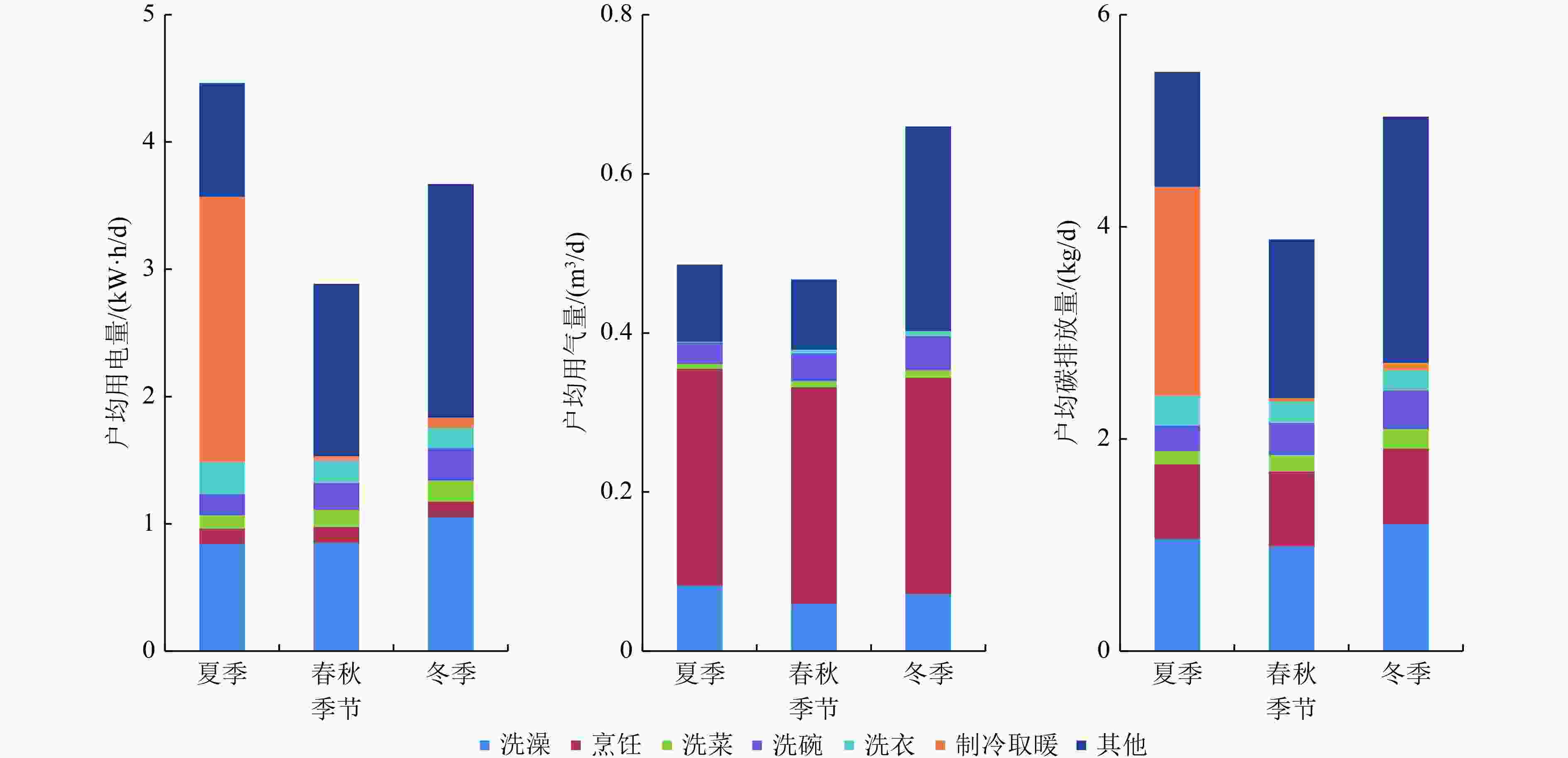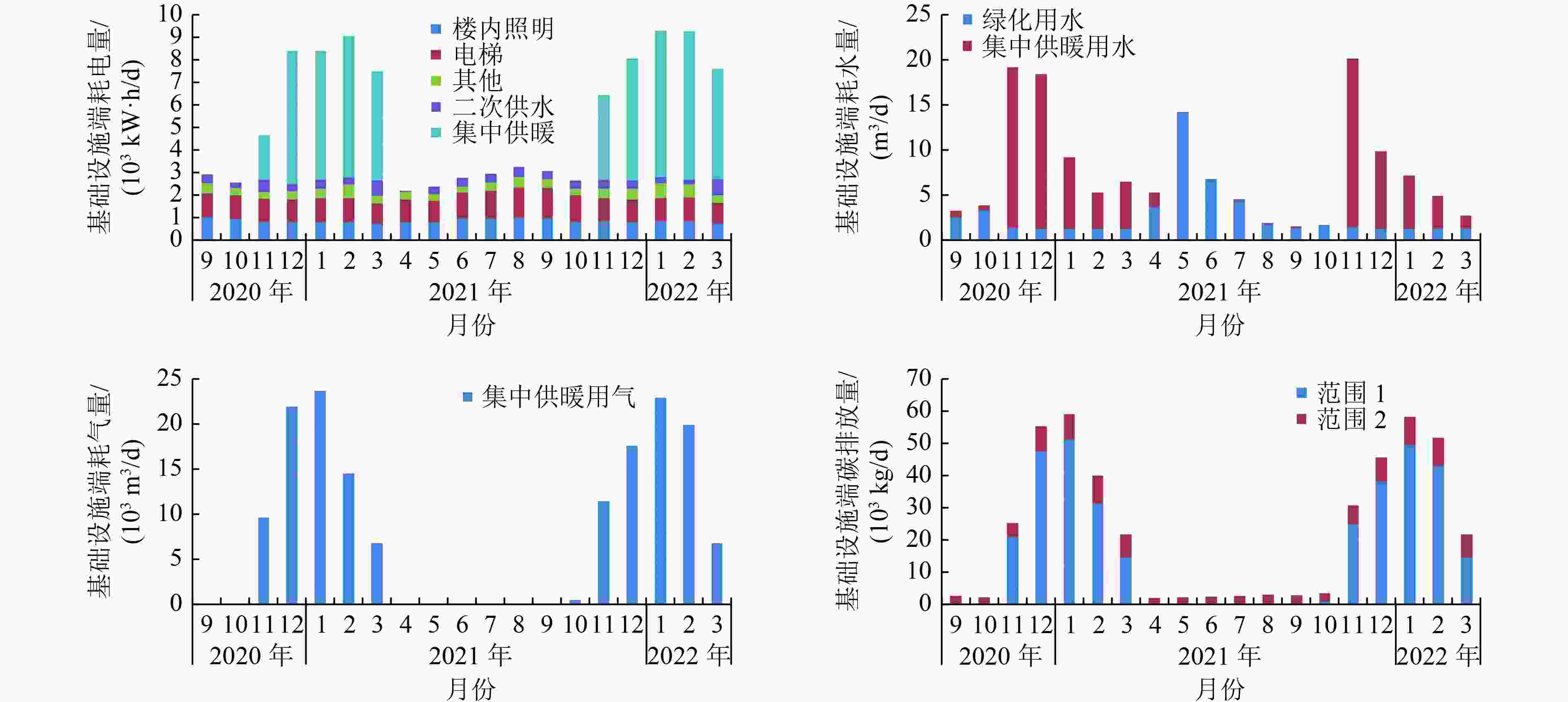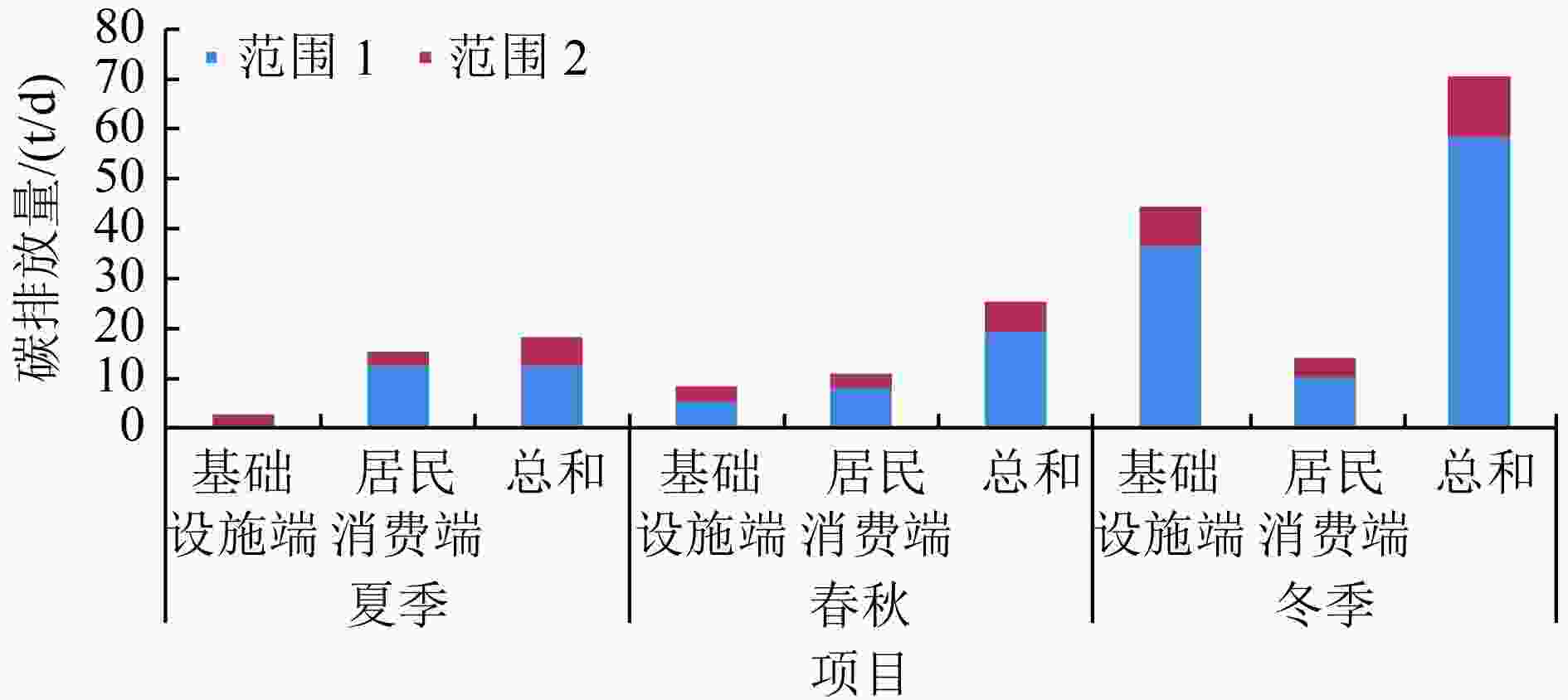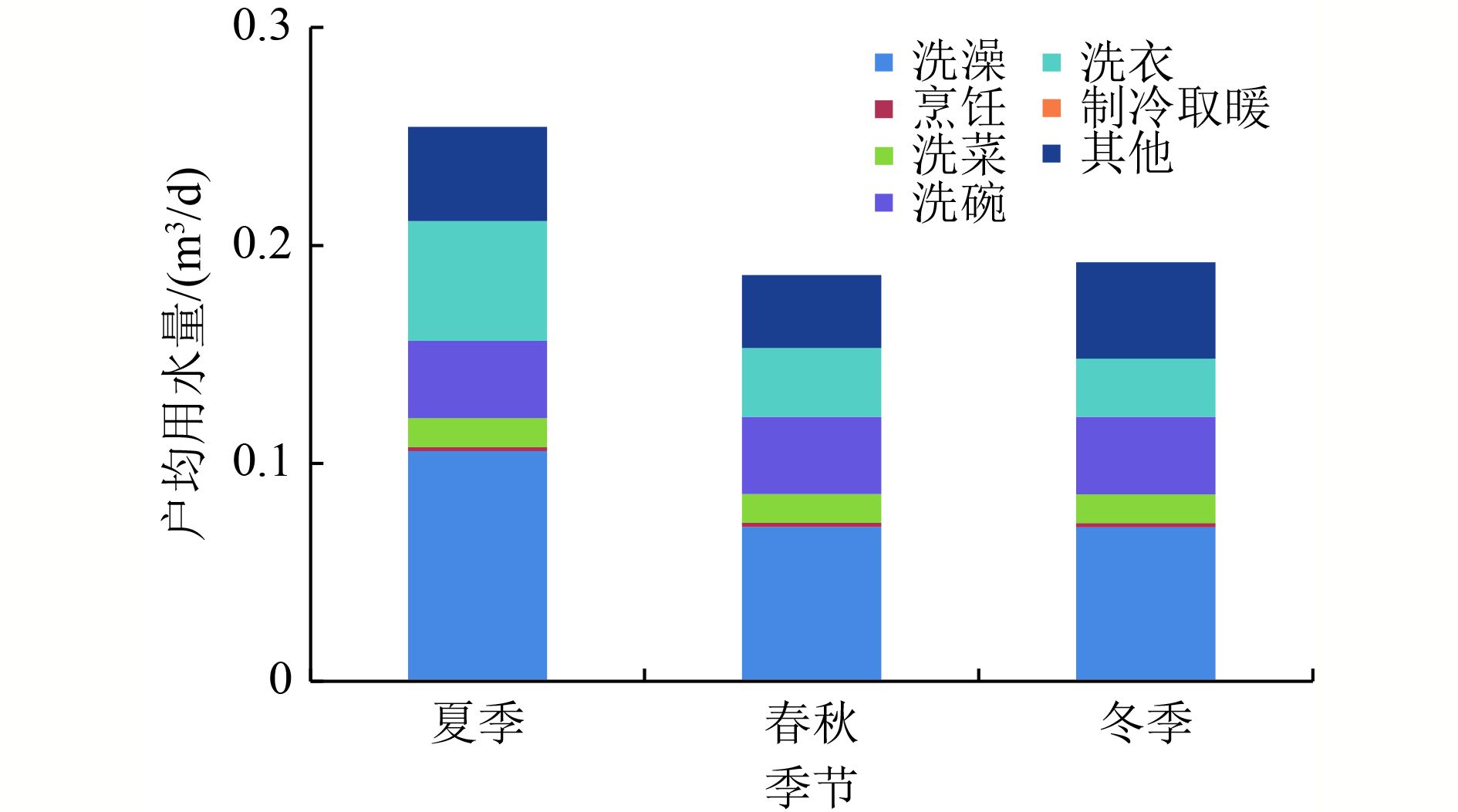Carbon emission accounting and impact assessment of water and energy consumption at a community scale
-
摘要:
居民社区用水用能的碳排放与行为选择和技术水平有关,且随时间波动性强。通过智能监测、实地调研、问卷调查等多种方法,自下而上构建了涵盖居民社区水能消费行为和基础设施相关的碳排放核算方法并评估其影响。通过对北京市海淀区某社区的案例研究发现,该社区夏季、春秋季、冬季碳排放量分别为18.2~20.8、19.3~21.5、58.5~63.8 t/d(以二氧化碳计),不同季节周末日均碳排放量约为工作日的1.0~1.2倍,由于采暖等因素造成冬季碳排放是其他三季的3.0~3.1倍。从全年来看,社区基础设施端共排放二氧化碳6.98×103 t/a,居民消费端排放4.94×103 t/a,占比分别为58.7%和41.3%;案例社区的温室气体核算体系范围1(能源直接碳排放,即气耗)碳排放量为8.98×103 t/a,范围2(能源间接碳排放,即电耗和水耗)碳排放量为2.92×103 t/a,占比分别为75.4%和24.6%。研究结果表明,推动燃气设备等基础设施升级改造、倡导居民生活器具和行为方式节能化等途径是推动居民社区减碳和绿色低碳转型的重要手段。
Abstract:The carbon emissions of residents' water and energy use are related to their behaviour choice and technology level. The emissions also fluctuate greatly over time. Through intelligent monitoring, field research, questionnaires and other methods, a bottom-up carbon emission accounting method was developed, and its impact was assessed from the perspective of community infrastructure and residential water and energy consumption. A community in Haidian District, Beijing, was selected as a case in this study. The total carbon emission of this community was 18.2-20.8, 19.3-21.5, and 58.5-63.8 t/d in terms of CO2 in summer, spring/autumn and winter, respectively. The average daily carbon emission of residential consumption on weekend was 1.0-1.2 times that of weekday.
-
-
[1] 吴永强, 李明凯, 唐中楠, 等.基于灰色动态模型群的衡水市居民年用水量预测[J]. 环境工程技术学报,2022,12(1):267-274. doi: 10.12153/j.issn.1674-991X.20210233WU Y Q, LI M K, TANG Z N, et al. Projection of residential annual water consumption in Hengshui City based on dynamic gray model groups[J]. Journal of Environmental Engineering Technology,2022,12(1):267-274. doi: 10.12153/j.issn.1674-991X.20210233 [2] 周扬胜.北京市城乡供热取暖清洁化历程及启示[J]. 环境与可持续发展,2020,45(3):57-66. doi: 10.19758/j.cnki.issn1673-288x.202003057ZHOU Y S. Processes and enlightenment of urban-rural clean heating in Beijing[J]. Environment and Sustainable Development,2020,45(3):57-66. doi: 10.19758/j.cnki.issn1673-288x.202003057 [3] 王春艳, 周雨澎, 尤恺杰, 等.北京市居民家庭水—能消费活动碳核算及影响因素分析[J]. 中国环境管理,2021,13(3):56-65. doi: 10.16868/j.cnki.1674-6252.2021.03.056WANG C Y, ZHOU Y P, YOU K J, et al. Analysis of carbon emissions accounting and influencing factors of water-energy consumption behaviors in Beijing residents[J]. Chinese Journal of Environmental Management,2021,13(3):56-65. doi: 10.16868/j.cnki.1674-6252.2021.03.056 [4] 王悦, 李锋, 陈新闯, 等.典型社区家庭消费碳排放特征与影响因素: 以北京市为例[J]. 生态学报,2019,39(21):7840-7853.WANG Y, LI F, CHEN X C, et al. Characteristics and influencing factors of carbon emission from typical community household consumption: a case of Beijing[J]. Acta Ecologica Sinica,2019,39(21):7840-7853. [5] 陈豹. 北京市家庭碳排放变化特征及影响因素研究[D]. 北京: 北京工业大学, 2015. [6] 杨琪. 城市居民家庭生活用水过程中的能耗分析: 以兰州城区为例[D]. 兰州: 西北师范大学, 2014. [7] 北京市质量技术监督局. 社区低碳运行管理通则: DB11/T 1532—2018[S]. 北京: 中国标准出版社, 2018. [8] 马国栋.居民节水行为与节水型社区建设探析[J]. 管理观察,2018(33):44-47. doi: 10.3969/j.issn.1674-2877.2018.33.017MA G D. Residents' water-saving behaviors and the construction of water-saving community[J]. Management Observer,2018(33):44-47. doi: 10.3969/j.issn.1674-2877.2018.33.017 [9] LI Y, YANG J, ZHANG N. City resident daily water amount predicting method, involves determining forecast city resident daily water quantity, determining stage prediction time, obtaining total water quantity prediction data, and determining total water quantity,CN105868852-A[P]. 2016-08-17. [10] HARRIDEN K. Water diaries: generate intra-household water use data–generate water use behaviour change[J]. Journal of Water, Sanitation and Hygiene for Development,2013,3(1):70-80. doi: 10.2166/washdev.2013.015 [11] SUN W, ZHANG J, LIU W. Data-driven method for evaluating residential power efficiency, involves combining horizontal and vertical scores to establish comprehensive scoring standard for energy use behavior of residents, and feedback scoring results to residents: CN111626536-A[P]. 2019-12-26. [12] 陈淑琴, 沈恒根, 李念平, 等. 住宅建筑能量信息系统综合评价模型研究[C]//全国暖通空调制冷2010年学术年会, 2010. [13] 初旭明.改造社区供暖系统提高能效[J]. 中国石化,2012(6):38. doi: 10.3969/j.issn.1005-457X.2012.06.021 [14] 裴婷.基于负荷预测的超高层建筑供水系统能耗综合优化方法[J]. 河南科学,2021,39(7):1086-1091. doi: 10.3969/j.issn.1004-3918.2021.07.009PEI T. Comprehensive optimization method of energy consumption for water supply system of super high-rise building based on load forecasting[J]. Henan Science,2021,39(7):1086-1091. doi: 10.3969/j.issn.1004-3918.2021.07.009 [15] WOLMAN A. The metabolism of cities[J]. Scientific American,1965,213:179-190. [16] CHRISTEN A, COOPS N C, KELLETT R, etal. A LiDAR-based urban metabolism approach to neighborhoods scale energy and carbon emissions modelling[D]. Vancouver: University of British Columbia, 2010. [17] CHRISTEN A, COOPS N C, CRAWFORD B R, et al. Validation of modeled carbon-dioxide emissions from an urban neighborhood with direct eddy-covariance measurements[J]. Atmospheric Environment,2011,45(33):6057-6069. doi: 10.1016/j.atmosenv.2011.07.040 [18] HEINONEN J, JALAS M, JUNTUNEN J K, et al. Situated lifestyles: I. How lifestyles change along with the level of urbanization and what the greenhouse gas implications are: a study of Finland[J]. Environmental Research Letters,2013,8(2):025003. doi: 10.1088/1748-9326/8/2/025003 [19] 姜华, 李艳萍, 高健, 等.关于统筹建立二氧化碳排放总量控制制度的思考[J]. 环境工程技术学报,2022,12(1):1-5.JIANG H, LI Y P, GAO J, et al. Thoughts on the overall establishment of total carbon dioxide emission control system[J]. Journal of Environmental Engineering Technology,2022,12(1):1-5. [20] 叶瑞克, 李亦唯, 高壮飞, 等.城市建筑群碳排放核算模型构建与实证研究[J]. 资源开发与市场,2017,33(11):1295-1299. doi: 10.3969/j.issn.1005-8141.2017.11.003YE R K, LI Y W, GAO Z F, et al. Urban building group carbon emission accounting model construct and empirical research[J]. Resource Development & Market,2017,33(11):1295-1299. doi: 10.3969/j.issn.1005-8141.2017.11.003 [21] JONES C M, KAMMEN D M. Quantifying carbon footprint reduction opportunities for US households and communities[J]. Environmental Science & Technology,2011,45(9):4088-4095. [22] MATTINEN M K, HELJO J, VIHOLA J, et al. Modeling and visualization of residential sector energy consumption and greenhouse gas emissions[J]. Journal of Cleaner Production,2014,81:70-80. doi: 10.1016/j.jclepro.2014.05.054 [23] 沈岩, 武彤冉, 闫静, 等.基于COPERT模型北京市机动车大气污染物和二氧化碳排放研究[J]. 环境工程技术学报,2021,11(6):1075-1082. doi: 10.12153/j.issn.1674-991X.20210289SHEN Y, WU T R, YAN J, et al. Investigation on air pollutants and carbon dioxide emissions from motor vehicles in Beijing based on COPERT model[J]. Journal of Environmental Engineering Technology,2021,11(6):1075-1082. doi: 10.12153/j.issn.1674-991X.20210289 [24] WRI, WBCSD. Greenhouse gas protocol[S/OL].[2022-04-26]. https://ghgprotocol.org/. [25] 国家统计局能源统计司. 中国能源统计年鉴(2019年)[M]. 北京: 中国统计出版社, 2020. [26] 国家发展和改革委员会应对气候变化司. 2019中国区域电网基准线排放因子[EB/OL]. [2022-07-01]. https://www.mee.gov.cn/ywgz/ydqhbh/wsqtkz/202012/t20201229_815386.shtml. [27] 国家发展和改革委员会应对气候变化司. 省级温室气体清单编制指南[R]. 北京: 国家发展和改革委员会应对气候变化司, 2011. [28] 北京市自来水集团. 北京市自来水集团2019年社会责任报告[EB/OL]. [2022-04-18]. https://www.bjwatergroup.com.cn/#/waterSupply/1/157. [29] ZHANG J B, SHAO Y T, WANG H C, et al. Current operation state of wastewater treatment plants in urban China[J]. Environmental Research,2021,195:110843. doi: 10.1016/j.envres.2021.110843 [30] 袁闪闪, 陈潇君, 杜艳春, 等.中国建筑领域CO2排放达峰路径研究[J]. 环境科学研究,2022,35(2):394-404.YUAN S S, CHEN X J, DU Y C, et al. Pathway of carbon emission peak of China's building sector[J]. Research of Environmental Sciences,2022,35(2):394-404. [31] 詹梨苹, 赵锐, 刘思瑶, 等.基于清单核算法的社区碳排放时空分布特征[J]. 四川环境,2020,39(3):182-188. doi: 10.14034/j.cnki.schj.2020.03.032ZHAN L P, ZHAO R, LIU S Y, et al. Spatial and temporal distribution characteristics of community carbon emissions based on inventory accounting method[J]. Sichuan Environment,2020,39(3):182-188. ⊕ doi: 10.14034/j.cnki.schj.2020.03.032 -




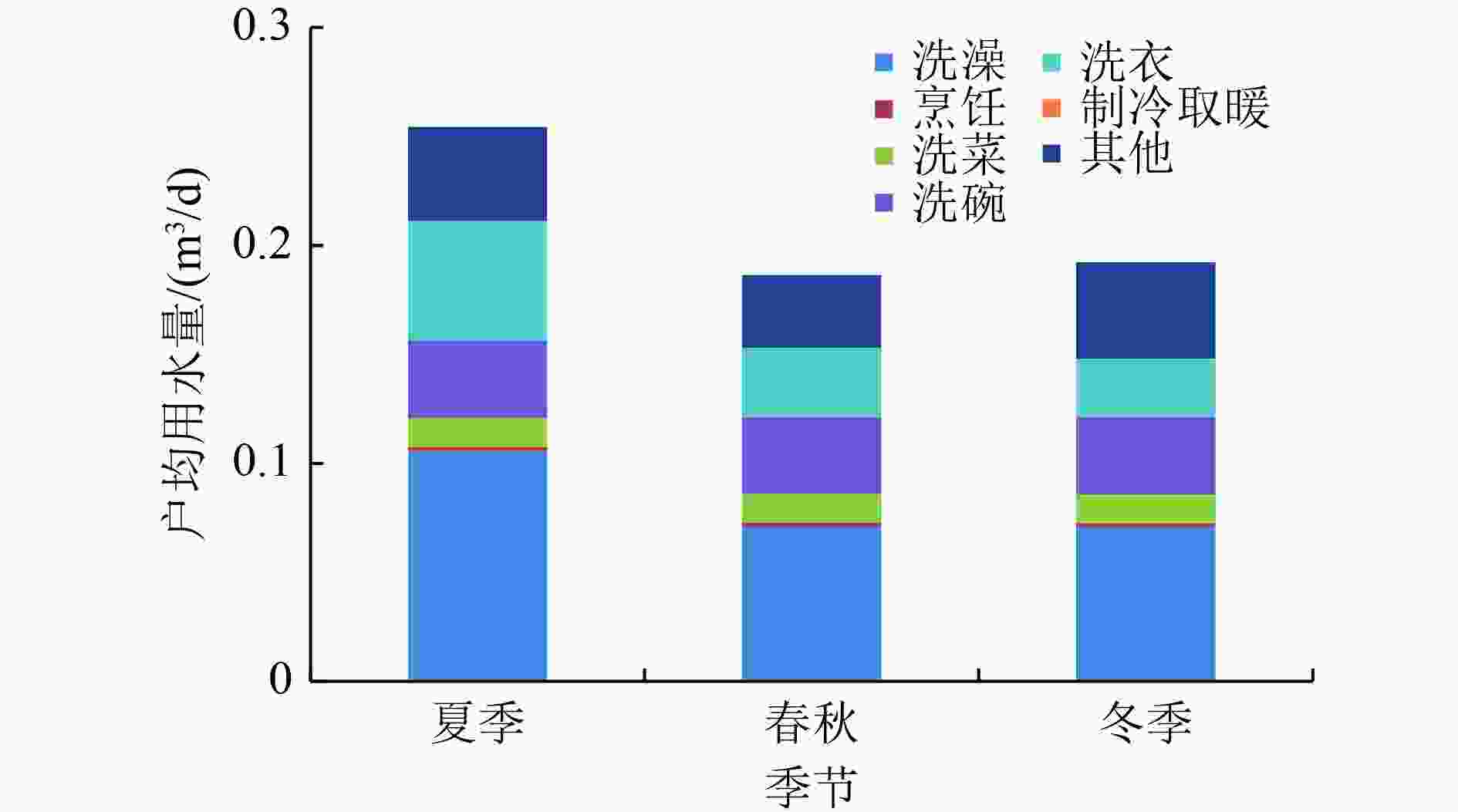
 下载:
下载:
